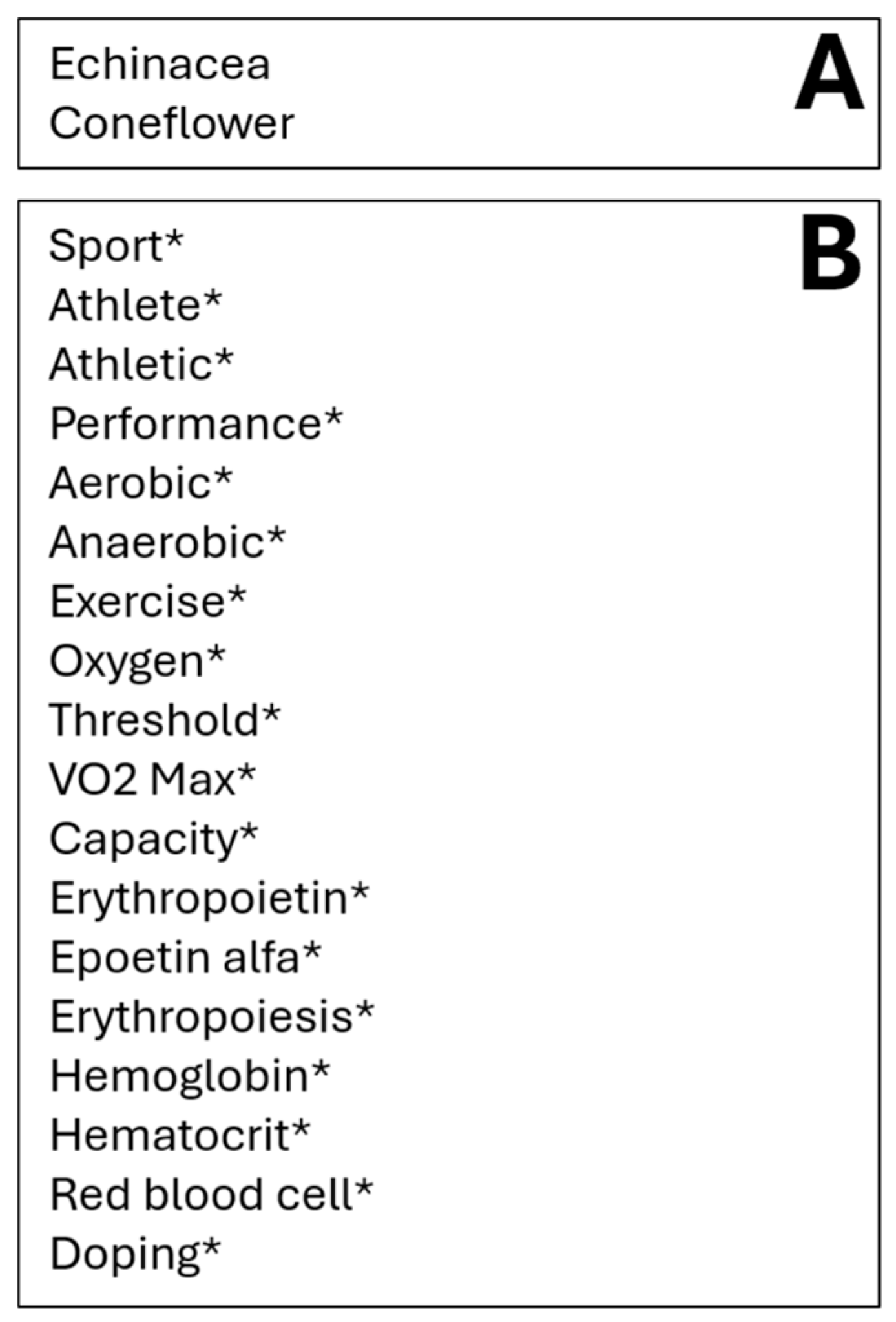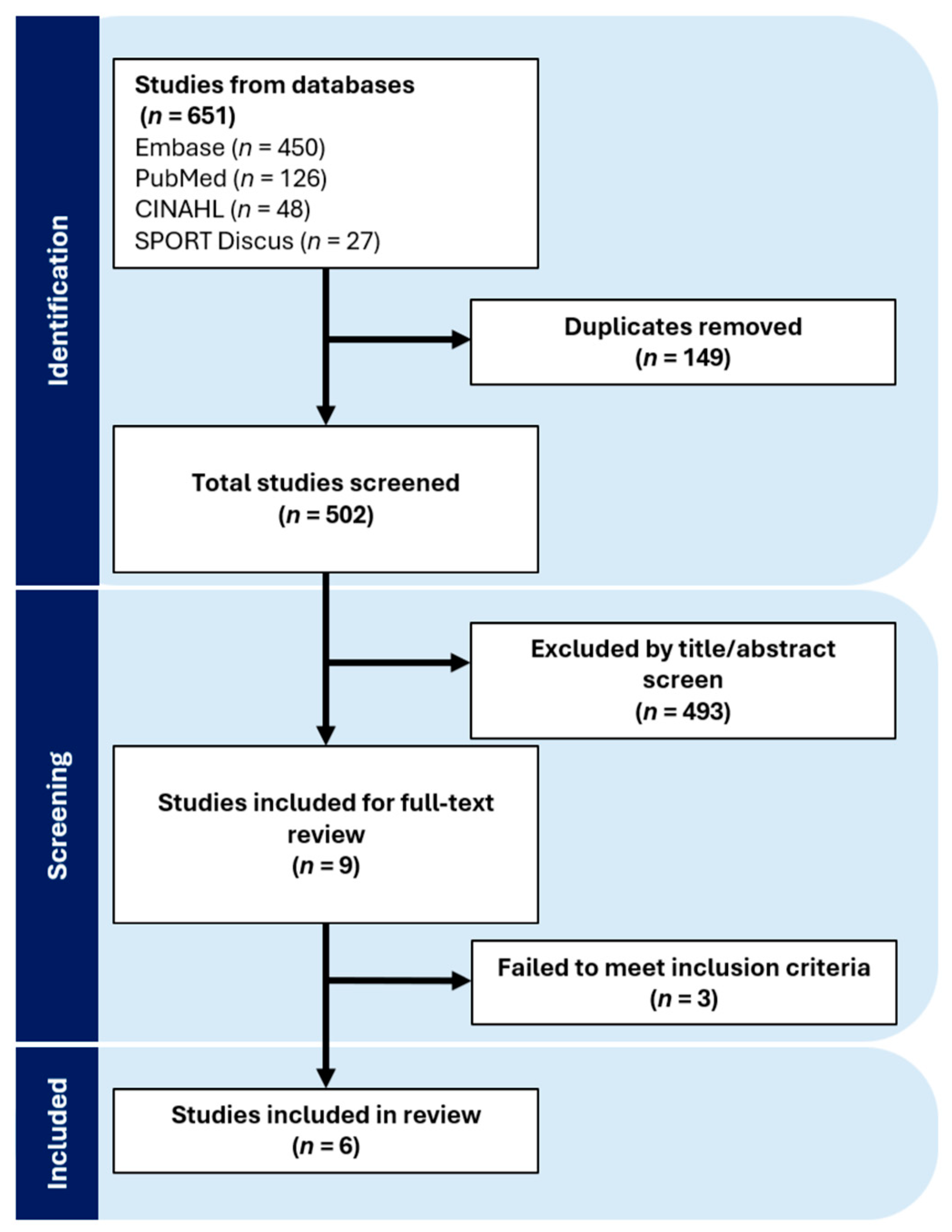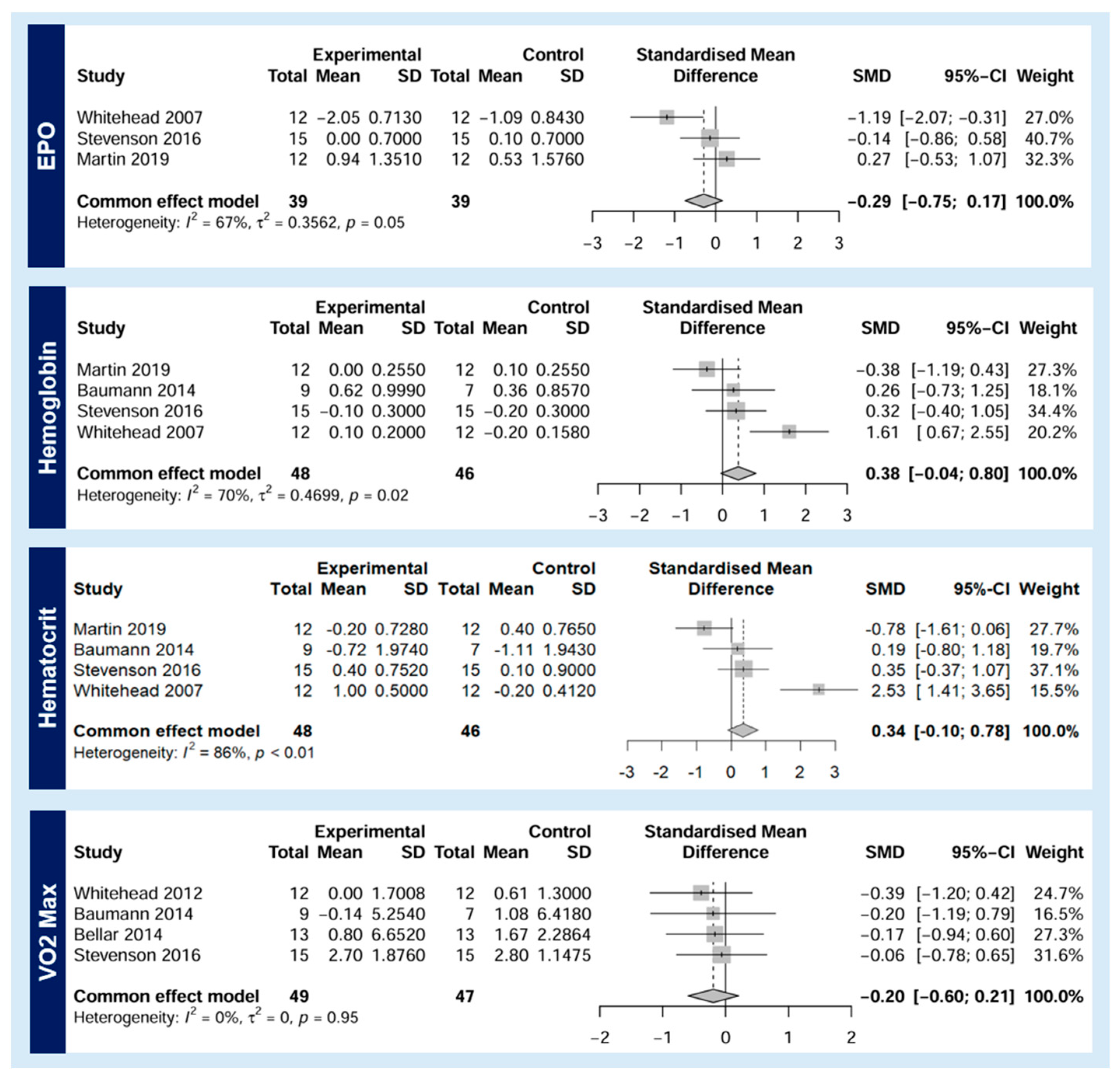Echinacea Supplementation Does Not Impact Aerobic Capacity and Erythropoiesis in Athletes: A Meta-Analysis
Abstract
1. Introduction
2. Materials and Methods
2.1. Search Strategy
2.2. Study Screening and Data Extraction
2.3. Statistical Analysis
3. Results
4. Discussion
5. Conclusions
Author Contributions
Funding
Data Availability Statement
Conflicts of Interest
References
- Manayi, A.; Vazirian, M.; Saeidnia, S. Echinacea purpurea: Pharmacology, phytochemistry and analysis methods. Pharmacogn. Rev. 2015, 9, 63–72. [Google Scholar] [CrossRef] [PubMed]
- Shah, S.A.; Sander, S.; White, C.M.; Rinaldi, M.; Coleman, C.I. Review Evaluation of echinacea for the prevention and treatment of the common cold: A meta-analysis. Lancet Infect. Dis. 2007, 7, 473–480. [Google Scholar] [CrossRef]
- Stimpel, M.; Proksch, A.; Wagner, H.; Lohmann-Matthes, M.L. Macrophage activation and induction of macrophage cytotoxicity by purified polysaccharide fractions from the plant Echinacea purpurea. Infect. Immun. 1984, 46, 845–849. [Google Scholar] [CrossRef]
- Burger, R.A.; Torres, A.R.; Warren, R.P.; Caldwell, V.D.; Hughes, B.G. Echinacea-induced cytokine production by human macrophages. Int. J. Immunopharmacol. 1997, 19, 371–379. [Google Scholar] [CrossRef] [PubMed]
- Tie, R.; Li, H.; Cai, S.; Liang, Z.; Shan, W.; Wang, B.; Tan, Y.; Zheng, W.; Huang, H. Interleukin-6 signaling regulates hematopoietic stem cell emergence. Exp. Mol. Med. 2019, 51, 1–12. [Google Scholar] [CrossRef] [PubMed]
- Paulson, R.F.; Hariharan, S.; Little, J.A. Stress erythropoiesis: Definitions and models for its study. Exp. Hematol. 2020, 89, 43–54.e2. [Google Scholar] [CrossRef]
- O’Neill, W.; McKEE, S.; Clarke, A.F. Immunological and haematinic consequences of feeding a standardised Echinacea (Echinacea angustifolia) extract to healthy horses. Equine Veter-J. 2002, 34, 222–227. [Google Scholar] [CrossRef]
- Ahmed, H.; Kamel, K.I.; El-Sabeiy, M.E.; Zeitouny, M.H. Effect of echinacea extract supplementation on growth performance and hemo-biochemical traits of growing rabbits. Egypt Poult. Sci. 2008, 28, 1165–1180. [Google Scholar]
- Bassett, D.R., Jr.; Howley, E.T. Limiting factors for maximum oxygen uptake and determinants of endurance performance. Med. Sci. Sports Exerc. 2000, 32, 70–84. [Google Scholar] [CrossRef]
- Noakes, T.; Myburgh, K.; Schall, R. Peak treadmill running velocity during theVO2max test predicts running performance. J. Sports Sci. 1990, 8, 35–45. [Google Scholar] [CrossRef]
- Bentley, D.J.; Newell, J.; Bishop, D. Incremental exercise test design and analysis: Implications for performance diagnostics in endurance athletes. Sports Med. 2007, 37, 575–586. [Google Scholar] [CrossRef] [PubMed]
- Broxterman, R.M.; Wagner, P.D.; Richardson, R.S. Endurance exercise training changes the limitation on muscle VO2max in normoxia from the capacity to utilize O2 to the capacity to transport O2. J. Physiol. 2024, 602, 445–459. [Google Scholar] [CrossRef] [PubMed]
- Trinh, K.V.; Diep, D.; Chen, K.J.Q.; Huang, L.; Gulenko, O. Effect of erythropoietin on athletic performance: A systematic review and meta-analysis. BMJ Open Sport Exerc. Med. 2020, 6, e000716. [Google Scholar] [CrossRef] [PubMed]
- Agency, W.A.-D. World Anti-Doping Code International Standard Prohibited List. 2024. Available online: https://www.wada-ama.org/sites/default/files/2023-09/2024list_en_final_22_september_2023.pdf (accessed on 19 June 2024).
- Salamin, O.; Kuuranne, T.; Saugy, M.; Leuenberger, N. Erythropoietin as a performance-enhancing drug: Its mechanistic basis, detection, and potential adverse effects. Mol. Cell. Endocrinol. 2018, 464, 75–87. [Google Scholar] [CrossRef] [PubMed]
- Barrack, M.T.; Muster, M.; Nguyen, J.; Rafferty, A.; Lisagor, T. An investigation of habitual dietary supplement use among 557 NCAA Division I athletes. J. Am. Coll. Nutr. 2020, 39, 619–627. [Google Scholar] [CrossRef]
- Barrack, M.; Fredericson, M.; Dizon, F.; Tenforde, A.; Kim, B.; Kraus, E.; Kussman, A.; Singh, S.; Nattiv, A. Dietary supplement use according to sex and triad risk factors in collegiate endurance runners. J. Strength Cond. Res. 2021, 35, 404–410. [Google Scholar] [CrossRef] [PubMed]
- Lun, V.; Erdman, K.A.; Fung, T.S.; Reimer, R.A. Dietary supplementation practices in Canadian high-performance athletes. Int. J. Sport Nutr. Exerc. Metab. 2012, 22, 31–37. [Google Scholar] [CrossRef]
- Whitehead, M.T.; Martin, T.D.; Scheett, T.P.; Webster, M.J. Running economy and maximal oxygen consumption after 4 weeks of echinacea supplementation. J. Strength Cond. Res. 2012, 26, 1928–1933. [Google Scholar] [CrossRef] [PubMed]
- Baumann, C.W.; Bond, K.L.; Rupp, J.C.; Ingalls, C.P.; Doyle, J.A. Echinacea purpurea supplementation does not enhance VO2max in distance runners. J. Strength Cond. Res. 2013, 28, 1367–1372. [Google Scholar] [CrossRef]
- Martin, T.D.; Green, M.S.; Whitehead, M.T.; Scheett, T.P.; Webster, M.J.; Hudson, G.M. Six weeks of oral Echinacea purpurea supplementation does not enhance the production of serum erythropoietin or erythropoietic status in recreationally active males with above-average aerobic fitness. Appl. Physiol. Nutr. Metab. 2019, 44, 791–795. [Google Scholar] [CrossRef]
- Bellar, D.; Moody, K.M.; Richard, N.S.; Judge, L.W. Efficacy of a Botanical Supplement with Concentrated Echinacea purpurea for Increasing Aerobic Capacity. ISRN Nutr. 2014, 2014, 149549. [Google Scholar] [CrossRef] [PubMed][Green Version]
- Baumann, C.W.; Kwak, D. Echinacea supplementation: Does it really improve aerobic fitness? J. Exerc. Nutr. Biochem. 2016, 20, 1. [Google Scholar] [CrossRef] [PubMed]
- Turner, L.; Shamseer, L.; Altman, D.G.; Weeks, L.; Peters, J.; Kober, T.; Dias, S.; Schulz, K.F.; Plint, A.C.; Moher, D. Consolidated standards of reporting trials (CONSORT) and the completeness of reporting of randomised controlled trials (RCTs) published in medical journals. Cochrane Database Syst. Rev. 2012, 11, MR000030. [Google Scholar] [CrossRef] [PubMed]
- Moher, D.; Hopewell, S.; Schulz, K.F.; Montori, V.; Gøtzsche, P.C.; Devereaux, P.J.; Elbourne, D.; Egger, M.; Altman, D.G. CONSORT 2010 explanation and elaboration: Updated guidelines for reporting parallel group randomised trials. Bmj 2010, 340, c869. [Google Scholar] [CrossRef] [PubMed]
- Higgins, J.P.T.; Altman, D.G.; Gøtzsche, P.C.; Jüni, P.; Moher, D.; Oxman, A.D.; Savović, J.; Schulz, K.F.; Weeks, L.; Sterne, J.A.C.; et al. The Cochrane Collaboration’s tool for assessing risk of bias in randomised trials. Bmj 2011, 343, d5928. [Google Scholar] [CrossRef]
- Dettori, J.R.; Norvell, D.C.; Chapman, J.R. Fixed-effect vs. random-effects models for meta-analysis: 3 points to consider. Glob. Spine J. 2022, 12, 1624–1626. [Google Scholar] [CrossRef]
- Whitehead, M.T.; Martin, T.D.; Scheett, T.P.; Webster, M.J. The effect of 4 weeks of oral echinacea supplementation on serum erythropoietin and indices of erythropoietic status. Int. J. Sport Nutr. Exerc. Metab. 2007, 17, 378–390. [Google Scholar] [CrossRef] [PubMed]
- Stevenson, J.L.; Krishnan, S.; Inigo, M.M.; Stamatikos, A.D.; Gonzales, J.U.; Cooper, J.A. Echinacea-based dietary supplement does not increase maximal aerobic capacity in endurance-trained men and women. J. Diet. Suppl. 2016, 13, 324–338. [Google Scholar] [CrossRef]
- Beheshti, A.; Chavanon, M.-L.; Christiansen, H. Emotion dysregulation in adults with attention deficit hyperactivity disorder: A meta-analysis. BMC Psychiatry 2020, 20, 120. [Google Scholar] [CrossRef]
- Chapman, R.F.; Karlsen, T.; Resaland, G.K.; Ge, R.L.; Harber, M.P.; Witkowski, S.; Stray-Gundersen, J.; Levine, B.D. Defining the “dose” of altitude training: How high to live for optimal sea level performance enhancement. J. Appl. Physiol. 2014, 116, 595–603. [Google Scholar] [CrossRef]
- Gore, C.J.; Sharpe, K.; Garvican-Lewis, L.A.; Saunders, P.U.; Humberstone, C.E.; Robertson, E.Y.; Wachsmuth, N.B.; Clark, S.A.; McLean, B.D.; Friedmann-Bette, B.; et al. Altitude training and haemoglobin mass from the optimised carbon monoxide rebreathing method determined by a meta-analysis. Br. J. Sports Med. 2013, 47, i31–i39. [Google Scholar] [CrossRef] [PubMed]
- Niemeyer, M.; Knaier, R.; Beneke, R. The oxygen uptake plateau—A critical review of the frequently misunderstood phenomenon. Sports Med. 2021, 51, 1815–1834. [Google Scholar] [CrossRef] [PubMed]
- Kaminsky, L.A.; Whaley, M.H. Evaluation of a new standardized ramp protocol: The BSU/Bruce ramp protocol. J. Cardiopulm. Rehabilitation 1998, 18, 438–444. [Google Scholar] [CrossRef] [PubMed]
- Poole, D.C.; Jones, A.M. Measurement of the maximum oxygen uptake Vo2max: Vo2peak is no longer acceptable. J. Appl. Physiol. 2017, 122, 997–1002. [Google Scholar] [CrossRef] [PubMed]
- Chidnok, W.; DiMenna, F.J.; Bailey, S.J.; Burnley, M.; Wilkerson, D.P.; Vanhatalo, A. VO2max is not altered by self-pacing during incremental exercise. Eur. J. Appl. Physiol. 2013, 113, 529–539. [Google Scholar] [CrossRef]
- Calabrese, E.J. ‘Hormesis: A Revolution in Toxicology, Risk Assessment and Medicine: Re-Framing the Dose-Response Relationship’. [Online]. Available online: https://www.embopress.org (accessed on 19 June 2024).
- Wiecha, S.; Kasiak, P.S.; Cieśliński, I.; Takken, T.; Palka, T.; Knechtle, B.; Nikolaidis, P.; Małek, A.; Postuła, M.; Mamcarz, A.; et al. External validation of VO2max prediction models based on recreational and elite endurance athletes. PLoS ONE 2023, 18, e0280897. [Google Scholar] [CrossRef]
- Faiss, R.; von Orelli, C.; Dériaz, O.; Millet, G.P. Responses to exercise in normobaric hypoxia: Comparison of elite and recreational ski mountaineers. Int. J. Sports Physiol. Perform. 2014, 9, 978–984. [Google Scholar] [CrossRef] [PubMed]
- Paul, R.W.; Sonnier, J.H.; Johnson, E.E.; Hall, A.T.; Osman, A.; Connors, G.M.; Freedman, K.B.; Bishop, M.E. Inequalities in the evaluation of male versus female athletes in sports medicine research: A systematic review. Am. J. Sports Med. 2023, 51, 3335–3342. [Google Scholar] [CrossRef]
- Daher, J.; Mallick, M.; El Khoury, D. Prevalence of dietary supplement use among athletes worldwide: A scoping review. Nutrients 2022, 14, 4109. [Google Scholar] [CrossRef]
- Wirnitzer, K.; Motevalli, M.; Tanous, D.R.; Gregori, M.; Wirnitzer, G.; Leitzmann, C.; Rosemann, T.; Knechtle, B. Sex differences in supplement intake in recreational endurance runners—Results from the nurmi study (Step 2). Nutrients 2021, 13, 2776. [Google Scholar] [CrossRef]
- Mozetic, V.; Leonel, L.; Pacheco, R.L.; Latorraca, C.D.O.C.; Guimarães, T.; Logullo, P.; Riera, R. Reporting quality and adherence of randomized controlled trials about statins and/or fibrates for diabetic retinopathy to the CONSORT checklist. Trials 2019, 20, 729. [Google Scholar] [CrossRef] [PubMed]


| Study | n | Population | Female n | Intervention | Length of Intervention | Intervention n | Placebo n | Outcomes of Interest |
|---|---|---|---|---|---|---|---|---|
| Baumann et al., 2013 [20] | 16 | distance runners | not reported | 8000 mg daily ech | 42 days | 9 | 7 | VO2 Max, Hb, Hct |
| Stevenson et al., 2016 [29] | 30 | endurance-trained athletes | 15 | 8000 mg daily ech | 35 days | 15 | 15 | VO2 Max, Hb, Hct, EPO |
| Martin et al., 2019 [21] | 24 | above-average aerobic fitness | 0 | 8000 mg daily ech | 42 days | 12 | 12 | Hb, Hct, EPO |
| Whitehead et al., 2007 * [28] | 24 | recreational athletes | 0 | 8000 mg daily ech | 28 days | 12 | 12 | Hb, Hct, EPO |
| Whitehead et al., 2012 * [19] | 24 | recreational athletes | 0 | 8000 mg daily ech | 28 days | 12 | 12 | VO2 Max |
| Bellar et al., 2014 [22] | 13 | recreational athletes | 0 | 8000 mg daily ech † | 30 days | 13 | 0 | VO2 Max |
| Echinacea Group | Placebo Group | |||||||||||||||
|---|---|---|---|---|---|---|---|---|---|---|---|---|---|---|---|---|
| EPO mean (SD) | Hb mean (SD) | Hct mean (SD) | VO2 Max mean (SD) | EPO mean (SD) | Hb mean (SD) | Hct mean (SD) | VO2 Max mean (SD) | |||||||||
| pre | post | pre | post | pre | post | pre | post | pre | post | pre | post | pre | post | pre | post | |
| Baumann 2013 [20] | - | - | 14.93 (1.27) | 15.55 (0.80) | 43.57 (2.38) | 42.85 (1.46) | 67.37 (4.62) | 67.23 (5.82) | - | - | 15.47 (0.9) | 15.83 (0.7) | 44.61 (2.4) | 43.5 (1.34) | 65.17 (6.60) | 66.25 (6.23) |
| Stevenson 2016 [29] | 6.2 (0.6) | 6.2 (0.8) | 14.4 (0.3) | 14.3 (0.3) | 42.4 (0.8) | 42.8 (0.7) | 59.3 (1.95) | 62 (1.80) | 9.7 (0.8) | 9.8 (0.6) | 14.7 (0.3) | 14.5 (0.3) | 43.1 (0.9) | 43.2 (0.9) | 61.0 (1.45) | 63.8 (1.50) |
| Martin 2019 [21] | 7.92 (1.13) | 8.86 (1.54) | 14.8 (0.3) | 14.8 (0.2) | 42.9 (0.9) | 42.7 (0.5) | - | - | 9.21 (1.3) | 9.74 (1.81) | 15.0 (0.3) | 15.1 (0.2) | 43.2 (0.9) | 43.6 (0.6) | - | - |
| Whitehead 2007/2012 [19,28] | 12.37 (0.87) | 10.32 (0.51) | 14.5 (0.2) | 14.6 (0.2) | 41.9 (0.5) | 42.9 (0.5) | 43.8 (1.70) | 43.8 (1.70) * | 10.63 (0.68) | 9.54 (0.98) | 14.7 (0.1) | 14.5 (0.2) | 42.5 (0.3) | 42.3 (0.5) | 40.7 (1.3) | 41.31 (1.3) * |
| Bellar 2014 [22] | - | - | - | - | - | - | 51 (6.8) | 51.8 (6.5) | - | - | - | - | - | - | x | x |
Disclaimer/Publisher’s Note: The statements, opinions and data contained in all publications are solely those of the individual author(s) and contributor(s) and not of MDPI and/or the editor(s). MDPI and/or the editor(s) disclaim responsibility for any injury to people or property resulting from any ideas, methods, instructions or products referred to in the content. |
© 2024 by the authors. Licensee MDPI, Basel, Switzerland. This article is an open access article distributed under the terms and conditions of the Creative Commons Attribution (CC BY) license (https://creativecommons.org/licenses/by/4.0/).
Share and Cite
Deccy, S.; Bartkowiak, C.; Rodricks, N.; Paultre, K. Echinacea Supplementation Does Not Impact Aerobic Capacity and Erythropoiesis in Athletes: A Meta-Analysis. Nutrients 2024, 16, 1991. https://doi.org/10.3390/nu16131991
Deccy S, Bartkowiak C, Rodricks N, Paultre K. Echinacea Supplementation Does Not Impact Aerobic Capacity and Erythropoiesis in Athletes: A Meta-Analysis. Nutrients. 2024; 16(13):1991. https://doi.org/10.3390/nu16131991
Chicago/Turabian StyleDeccy, Stephanie, Callie Bartkowiak, Nathan Rodricks, and Kristopher Paultre. 2024. "Echinacea Supplementation Does Not Impact Aerobic Capacity and Erythropoiesis in Athletes: A Meta-Analysis" Nutrients 16, no. 13: 1991. https://doi.org/10.3390/nu16131991
APA StyleDeccy, S., Bartkowiak, C., Rodricks, N., & Paultre, K. (2024). Echinacea Supplementation Does Not Impact Aerobic Capacity and Erythropoiesis in Athletes: A Meta-Analysis. Nutrients, 16(13), 1991. https://doi.org/10.3390/nu16131991






